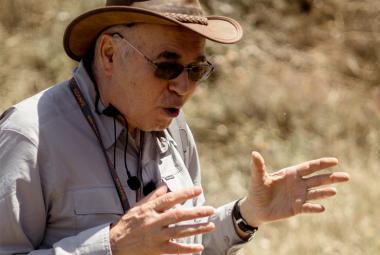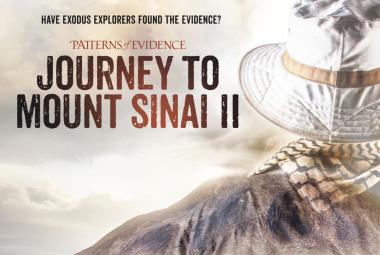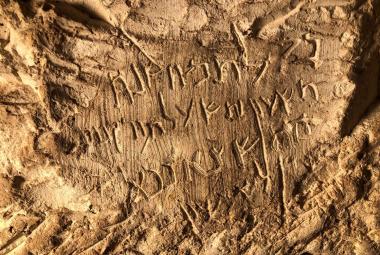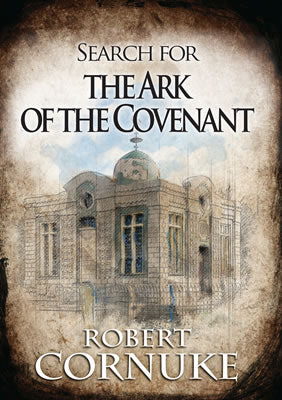[This article is the first in a series regarding some of the startling disclosures that were presented jointly by Bob Cornuke and Chuck Missler at the Prophecy Summit at Branson, Missouri, August 22-24, 2001.]
The Mystery of the Lost Ark
The Ark of the Covenant, a prominent fixture in the narratives of the Old Testament, certainly seems to have disappeared from view after the Babylonian captivity, which began in 606 B.C. There are many theories as to what happened to the Ark of the Covenant. This issue was, of course, popularized in the well-attended fantasy movie, Raiders of the Lost Ark.
Among the many theories as to its subsequent whereabouts, the "official" position by conservative rabbis in Israel - and also the Temple Institute - is that it remains hidden in some secret location under the Temple Mount to this day. But there are many who doubt this. Some believe it was among the items plundered by the Babylonians during the captivity (however, it is conspicuously absent from the detailed inventories associated with those events). Some believe it was taken by Pharaoh Shishak;1 others believe it was hidden by Jeremiah on Mt. Nebo.2 Ron Wyatt claimed to have found it under Golgatha. Each of these views has various scholastic and technical rebuttals.
Many link its future to the rebuilding of the Temple that appears to be destined before the Second Coming of Christ. We know that the Temple will be rebuilt at that time: Jesus,3 Paul, 4 and John5 each make reference to it. However, the Ark of the Covenant is not an essential. The Tenach, the Tosephta, and the Mishna, regarded as the primary authorities in these matters, all indicate procedural steps regarding its absence. The Ark of the Covenant was not in Herod's Temple, the Temple that was standing during the ministry of Christ.
The Ethiopian Tradition
Many of us have heard of the belief that the Ark was taken to Ethiopia by Menelik I, the offspring of Solomon and the Queen of Sheba who, raised by priests until he was of age, and then leaving behind a replica, removed the Ark to separate it from Solomon's apostasy. (These ideas were developed by Graham Hancock in his book, The Sign and the Seal, 6 and also popularized by Grant Jeffrey in some of his publications.) Emperor Haile Selassie has been regarded as the 225th descendant of Menelik, and these traditions continue to be embraced by the current leadership of the government of Ethiopia.
The idea that the Ark is presently ensconced in Ethiopia is a well-documented tradition dating from at least 642 B.C. when it ostensibly was at Elephantine Island, in Egypt; then moved to Tana Kirkos Island, Lake Tana, Ethiopia; and finally to its present site in a well-protected bunker at St. Mary's of Zion Church at Axum, Ethiopia. The Ethiopians believe that it is destined to be delivered to the Messiah when He reigns on Mt. Zion. 7 Most of us have dismissed these tales for various reasons, not the least of which is the fact that the Ark appears in the Scriptures well after Solomon.8 Perhaps the biggest death knell for these various theories would seem to occur in Jeremiah:
And it shall come to pass, when ye be multiplied and increased in the land, in those days, saith the LORD, they shall say no more, The ark of the covenant of the LORD: neither shall it come to mind: neither shall they remember it; neither shall they visit it; neither shall that be done any more.
Jeremiah 3:16
And yet there are some aspects of this mystery, in the Scriptures, that suggest a very different possibility. What may be presently in Ethiopia may have arrived there by a different path altogether, and may have a destiny that has been widely overlooked in the Biblical texts.
The Reign of Manasseh
The very positive reign of Hezekiah was, unfortunately, succeeded by his twelve-year-old son, Manasseh. Reigning for 55 years, and continuing the paganism of Ahaz, he relapsed into idolatry with all its vices. The worship of YHWH was banished; yet faithful prophets, including Isaiah and Micah, lifted up their voices in reproof and in warning. However, their fidelity only aroused bitter hatred, and a period of cruel persecution against all the friends of the traditional practices spread "blood from one border to the other." An ancient Jewish tradition indicates that at this time Isaiah was "sawn asunder."9
Manasseh was succeeded by Josiah, who led a significant revival and thereby gained a personal reprieve from the coming judgment that God had declared as a result of Manasseh's disasters.10
Behold, I will gather thee to thy fathers, and thou shalt be gathered to thy grave in peace, neither shall thine eyes see all the evil that I will bring upon this place, and upon the inhabitants of the same.
2 Chronicles 34:28
What is strange is that Josiah receives his instructions through Huldah the prophetess. Why not through the traditional path involving the Levites and the Ark of the Covenant? Josiah had instructed the Levites to return the Ark to the Temple:
And said unto the Levites that taught all Israel, which were holy unto the LORD, Put the holy ark in the house which Solomon the son of David king of Israel did build; it shall not be a burden upon your shoulders: serve now the LORD your God, and his people Israel...
2 Chronicles 35:3
The Ark was, obviously, not in the Temple at that time. It is a reasonable conjecture that the Levites, due to the widespread mischief of Manasseh, removed the Ark to a place of safekeeping: out of the Temple, out of Jerusalem, and probably out of the entire jurisdiction of Manasseh. It was apparently in transit: "a burden upon [their] shoulders." (This may also explain why Josiah had to resort to Huldah the prophetess for his counsel.) Notice that this was Josiah's request. There is no evidence that they complied (quite the contrary!).
Pharaoh Necho
The Assyrian Empire, which had ruled the region for many centuries, was on the wane, and Egypt's Pharaoh Necho was moving to pick up some of the pieces. But he is surprised that King Josiah was taking up arms against him. Pharaoh Necho's response is one of astonishment:
But he sent ambassadors to him, saying, What have I to do with thee, thou king of Judah? I come not against thee this day, but against the house wherewith I have war: for God commanded me to make haste: forbear thee from meddling with God, who is with me, that he destroy thee not.
2 Chronicles 35:21
Why would Josiah go against Pharaoh Necho? The Assyrians were the adversary of Judah as well. What did Josiah expect to gain from this aggressive commitment? And why did Pharaoh Necho believe that God was on his side? The Chronicler adds an additional provocative insight:
Nevertheless Josiah would not turn his face from him, but disguised himself, that he might fight with him, and hearkened not unto the words of Necho from the mouth of God, and came to fight in the valley of Megiddo.
2 Chronicles 35:22
How could Pharaoh Necho have heard the words "from the mouth of God"? Is it possible that the Levites had sought refuge from Manasseh in Egypt, and had set up shop there? Was this what Josiah was after? Was this how Necho heard "from the mouth of God"?
In any case, Josiah goes in disguise and gets killed at Megiddo. After this battle Necho marched on to Carchemish (a Syrian city on the middle Euphrates River), where he met and conquered the Assyrian army, and thus all the Syrian provinces and Israel came under his dominion. On his return march he deposed Jehoahaz, who had succeeded his father Josiah, and made Eliakim, Josiah's eldest son (whose name he changed to Jehoiakim), king. Jehoahaz he carried down into Egypt, where he died.11
Four years after this conquest, Necho again marched to the Euphrates, but this time his army was met and routed by the Chaldeans under a crown prince by the name of Nebuchadnezzar, who drove Necho back and took from him all the territory he had conquered, from the Euphrates unto the "river of Egypt." 12 The establishment of the Babylonian Empire would thus be the means that God would use to complete the judgment He had pronounced in response to Manasseh's disastrous reign. But what about the fabled Ark of the Covenant? Did the Levites continue to keep it separate from the vicissitudes in Judea? Did this begin its trek southward from Egypt to Ethiopia? (It is interesting to note that Pharaoh Necho II was not Egyptian: he was Ethiopian. He was the grandson of Necho I, of the 25th, or Ethiopian, dynasty.13 )
More Surprises to Come
In the next article we will explore some common misconceptions about the ancient relic that may presently reside under such diligent care in Ethiopia. Perhaps it is not the Ark of the Covenant that is the key issue! There is a separate element of equipment that is closely associated with the Ark, but has a distinct purpose and, perhaps, a distinct destiny: the Mercy Seat.
And, perhaps, there is also a uniquely distinctive role that was involved in the incident with Philip and the Ethiopian treasurer in Acts Chapter 8. Join us for some startling conjectures in the next issue.
[This article was, in large measure, the result of the many visits to Ethiopia by Bob Cornuke and research notes by Ken Durham. Bob can be contacted at the Biblical Archaeology Search & Exploration (BASE) Institute: (719) 540-9799 or www.baseinstitute.org.]
Notes:
- 2 Chronicles 12:9. It was a variant of these theories that was the basis for the fictional movie.
- 2 Maccabees 2:4, 5.
- Matthew 25:15.
- 2 Thessalonians 2:4f.
- Revelation 11:1, 2.
- Graham Hancock, The Sign and the Seal , Crown Publishers, New York, 1992.
- Isaiah 18 and Zephaniah 3:10 are Scriptures that suggest this.
- 2 Chronicles 35:3.
- 2 Kings 21:16; 24:3, 4; Jeremiah 2:30; Hebrews 11:37.
- 2 Kings 21:9-16.
- 2 Kings 23:31 2 Chronicles 36:1-4.
- Jeremiah 46:2; 2 Kings 24:7, 8.
- H.D.M. Spence and Joseph S. Exell, The Pulpit Commentary, Wm. B. Eerdmans Publishing Co., Grand Rapids MI, 1950, Vol 6, p.436.







